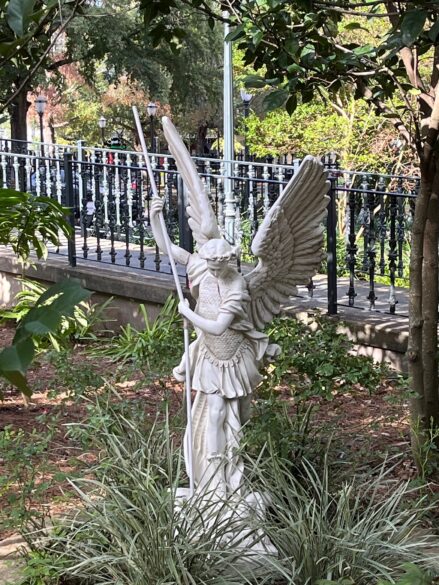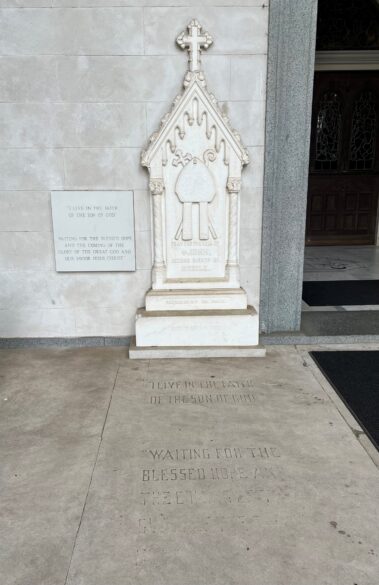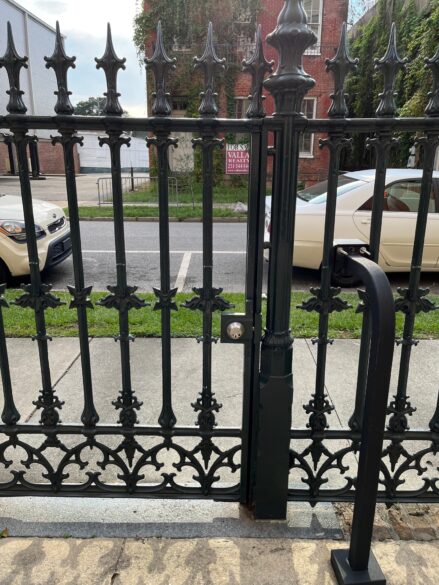From the Archives
By Mary Woodward
At the end of September, I made a trip to Mobile for my birthday and found myself in the gardens of the Cathedral Basilica of the Immaculate Conception late in the afternoon. The gardens outside the cathedral are filled with flora of the region and statues scattered among the palms and caladiums.
It was a beautiful day with cooler temps and low humidity, so I became engrossed in taking photos of various elements. Losing track of time, I found myself locked inside the garden at the end of the workday on a Friday. I could think of much worse places to be trapped, but I did not relish the thought of climbing the gate to get out.

Fortunately, the rector was nearby when I called the office, and he ventured over to unlock the back gate. Kindly smiling and assuring me I was not the first nor would I be the last to be in this predicament, he also gave me a great tour and history of the Lady Banksia on the back fence.
Reflecting on that experience, I began to think of the unique connections that dioceses and bishops have with one another. Our diocese was the 13th diocese established in the United States on July 28, 1837. Nashville and Dubuque were established the same day, but we claim pride of place due to strategic location and age.
We have a unique communion with three venerable and historic archdiocesan sees – Baltimore, the primal see of the U.S.; New Orleans, our first metropolitan provincial see; and Mobile, our metropolitan see, where Mass was first celebrated in 1703.
Bishop John Joseph Chanche (1) and Bishop William Henry Elder (3) are natives and products of Baltimore both being ordained bishops in Assumption Cathedral there in 1841 and 1857. Bishop James Oliver Van de Velde (2) was ordained a priest in Baltimore in 1827.
In 1852, Bishop Chanche ordained Francis Xavier Leray a priest in Natchez. Leray went on to become Archbishop of New Orleans in 1883. Bishop Elder, in 1859, was co-consecrator of John Quinlan, second bishop of Mobile, and Dominic Manucy in 1874, who went on to become third bishop of Mobile.
Bishop Francis Janssens (4) was elevated to Archbishop of New Orleans in 1888 and was principal consecrator of Bishop Thomas Heslin (5) in St. Louis Cathedral in New Orleans in 1889. Prior to being elevated to bishop, Bishop Heslin was ordained a priest in the Cathedral Basilica of the Immaculate Conception in Mobile by Bishop John Quinlan in 1869.
Bishop Quinlan added the portico to the Mobile cathedral and is buried under it instead of in the crypt chapel. He will be able to see his portico again on the day of the resurrection of the dead when his tomb is opened.
In 1890, Bishop John Edward Gunn (6) was ordained a priest in Rome by the Latin Patriarch of Constantinople, which has nothing to do with the current thread but I thought it was really cool. In 1911, Bishop Gunn was ordained a bishop in Atlanta in Sacred Heart Church, which he built. Two of his three consecrating bishops were Archbishop James Hubert Blenk, Archbishop of New Orleans and fellow Marist, and Bishop Edward Allen of Mobile.
Bishop Richard Oliver Gerow (7) was born and raised in Mobile being baptized, confirmed; and in 1924 ordained a bishop in the Cathedral there by Bishop Allen. In 1927, Bishop Gerow was a co-consecrator of Archbishop Thomas Joseph Toolen of Mobile. Thirty years later, Bishop Gerow was principal consecrator of Vicksburg native, Joseph Bernard Brunini (8) in our Cathedral of Saint Peter the Apostle in Jackson. It was a co-cathedral then.


Bishop Quinlan’s grave in the portico of the Cathedral in Mobile. Pictured is the iron gate, Chancellor Mary Woodward decided wasn’t smart to climb after being locked in the Cathedral gardens in Mobile.
Bishop Brunini was a co-consecrator Joseph Lawson Howze as auxiliary of Jackson in 1973. Bishop Howze was a native of the Mobile area in Daphne and went on to become the first bishop of Biloxi when it was established in 1977.
Bishop William Russell Houck (9), a native of Mobile, was ordained a priest in the Mobile Cathedral in 1951. Another interesting aside, Bishop Houck was ordained a Bishop in Rome by St. Pope John Paul II in a group of 27 bishops ordained that day in 1979.
New Orleans native, Bishop Joseph Nunzio Latino (10) was ordained a priest in St. Louis Cathedral in New Orleans by Archbishop John Cody in 1963. Forty years later, he was ordained a bishop in our cathedral by Archbishop Oscar H. Lipscomb of Mobile. Bishop Houck served as a co-consecrator.
Bishop Joseph Richard Kopacz was ordained a bishop in our cathedral in 2014 by Archbishop Thomas J. Rodi, current metropolitan archbishop of Mobile and native of New Orleans.
Well, that was a whirlwind of trails and tributaries surrounding the episcopal lineage of our region that gives a glimpse of the extraordinary interconnectedness of our bishops and dioceses. Even more so it is a microcosm of apostolic succession.
All this inspiration of Catholic chronicles springs forth from a Cathedral garden’s locked gates on a Friday afternoon in September. I now know to set an alarm on my phone for 4:15 p.m. when I am wandering down historic pathways.
(Mary Woodward is Chancellor and Archivist for the Diocese of Jackson.)
